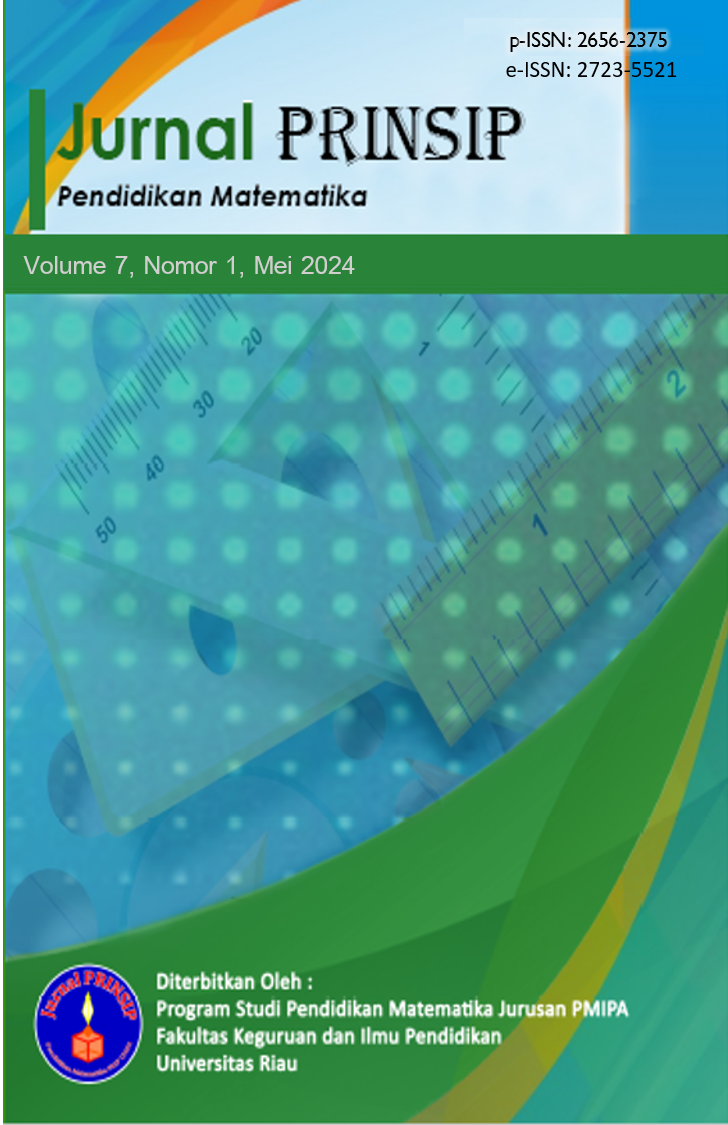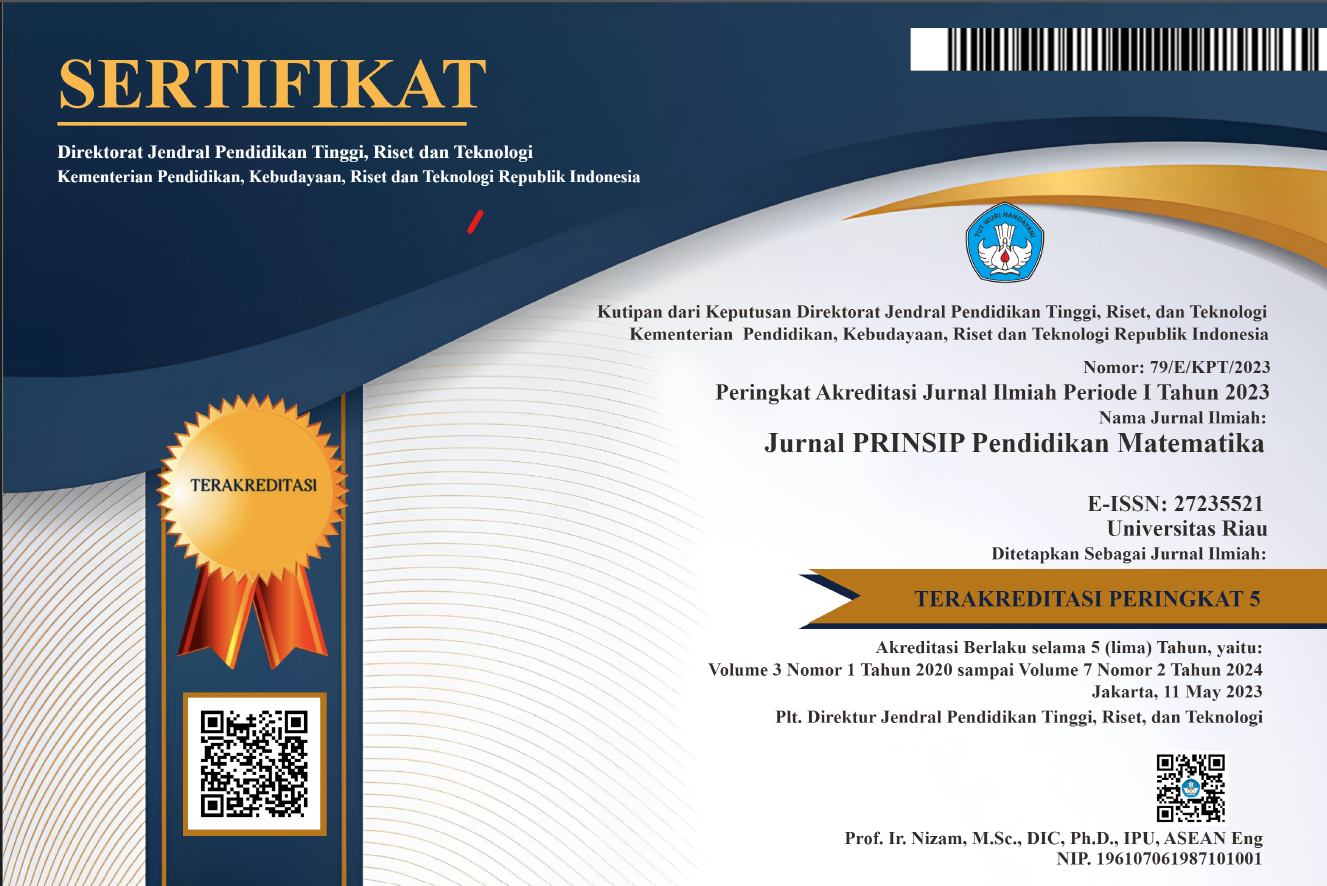IMPLEMENTATION OF THE PBL MODEL TO IMPROVE THE MATHEMATICAL PROBLEM-SOLVING ABILITY OF CLASS XII MIPA HIGH SCHOOL STUDENTS
Abstrak
This research aims to improve the learning process and mathematical problem-solving abilities (KPMM) of class XII MIPA students at SMA Negeri 1 Langgam by applying the Problem-Based Learning (PBL) model. This research is collaborative classroom action research, where researchers and mathematics teachers collaborate to implement the action. Researchers carry out actions while mathematics teachers act as observers during the learning process. This research took two cycles and used various learning tools and data collection instruments. The tools used include syllabus, Learning Implementation Plan (RPP), Student Worksheets (LKPD), teacher activity sheets, student activity sheets, and KPMM tests as data collection instruments. Analysis of activity sheets shows that there has been an improvement in the learning process, with learning becoming more in line with the implementation plan and students appearing more active. In addition, KPMM data analysis shows a significant increase from cycle I to cycle II, with the percentage of students who meet the KPMM criteria increasing from 69.39% in the first cycle to 83.80% in the second cycle. These findings conclude that applying the PBL model effectively improves the learning experience and KPMM results of students at SMA Negeri 1 Langgam in the 2023/2024 academic year.
##plugins.generic.usageStats.downloads##
Referensi
Arends, R. I. (2013). Belajar untuk Mengajar. Pustaka Pelajar.
Handayani, A., & Koeswanti, H. D. (2021). Meta-Analisis Model Pembelajaran Problem Based Learning (PBL) Untuk Meningkatkan Kemampuan Berpikir Kreatif. Jurnal Basicedu, 5(3), 1349–1355. https://doi.org/10.31004/basicedu.v5i3.924
Harahap, E. R., & Surya, E. (2017). Kemampuan Pemecahan Masalah Matematis Siswa Kelas VII Dalam Menyelesaikan Persamaan Linier Satu Variabel. Edumatica, 7(1), 44–54.
Hendra. (2018). Peningkatan Hasil Belajar Matematika Siswa Kelas XI IPA SMA Negeri 1 Bangkinang Melalui Model. Jurnal Cendekia: Jurnal Pendidikan Matematika, 2(2), 29–41.
Khairunnisa, N., Armis, & Heleni, S. (2022). Development of Learning Devices Based on PBL of Sets Material to Facilitate Mathematical Problem Solving Ability for Students in SMP/MTs. Jurnal PRINSIP Pendidikan Matematika, 5(1), 19–29.
Lestari, K. E., & Yudhanegara, M. R. (2017). Analisis Kemampuan Representasi Matematis Mahasiswa pada Mata Kuliah Geometri Transformasi Berdasarkan Latar Belakang Pendidikan Menengah. Jurnal Matematika Integratif, 13(1), 29. https://doi.org/10.24198/jmi.v13i1.11410
Mawaddah, S., & Anisah, H. (2015). Kemampuan Pemecahan Masalah Matematis Siswa Pada Pembelajaran Matematika dengan Menggunakag) di SMPn Model Pembelajaran Generatif (Generative Learning) di SMP. EDU-MAT: Jurnal Pendidikan Matematika, 3(2), 166–175. https://doi.org/10.20527/edumat.v3i2.644
Putra, J., & Yulita. (2019). Penerapan Model PBL Untuk Meningkatkan Kemampuan Pemecahan Masalah Matematika Peserta Didik Kelas XII MIPA 2 SMAN 12 Pekanbaru. Jurnal Prinsip Pendidikan Matematika, 1(2), 78–88.
Septiana, I. T., Wijayanti, O., & Muslim, A. (2019). Penerapan Model Problem Based Learning (PBL) untuk Meningkatkan Prestasi Belajar Matematika pada Siswa Kelas V Sekolah Dasar. Media Penelitian Pendidikan : Jurnal Penelitian Dalam Bidang Pendidikan Dan Pengajaran, 13(1), 14. https://doi.org/10.26877/mpp.v13i1.5084
Sulistiyana, & Saragih, S. (2023). Pengembangan Perangkat Pembelajaran Dengan Model Problem-Based Learning Untuk Memfasilitasi K. Jurnal Prinsip Pendidikan Matematika, 6(2), 162–176. https://doi.org/https://doi.org/10.33578/prinsip.v6i2.166
##submission.copyrightStatement##
##submission.license.cc.by-nc-sa4.footer##




